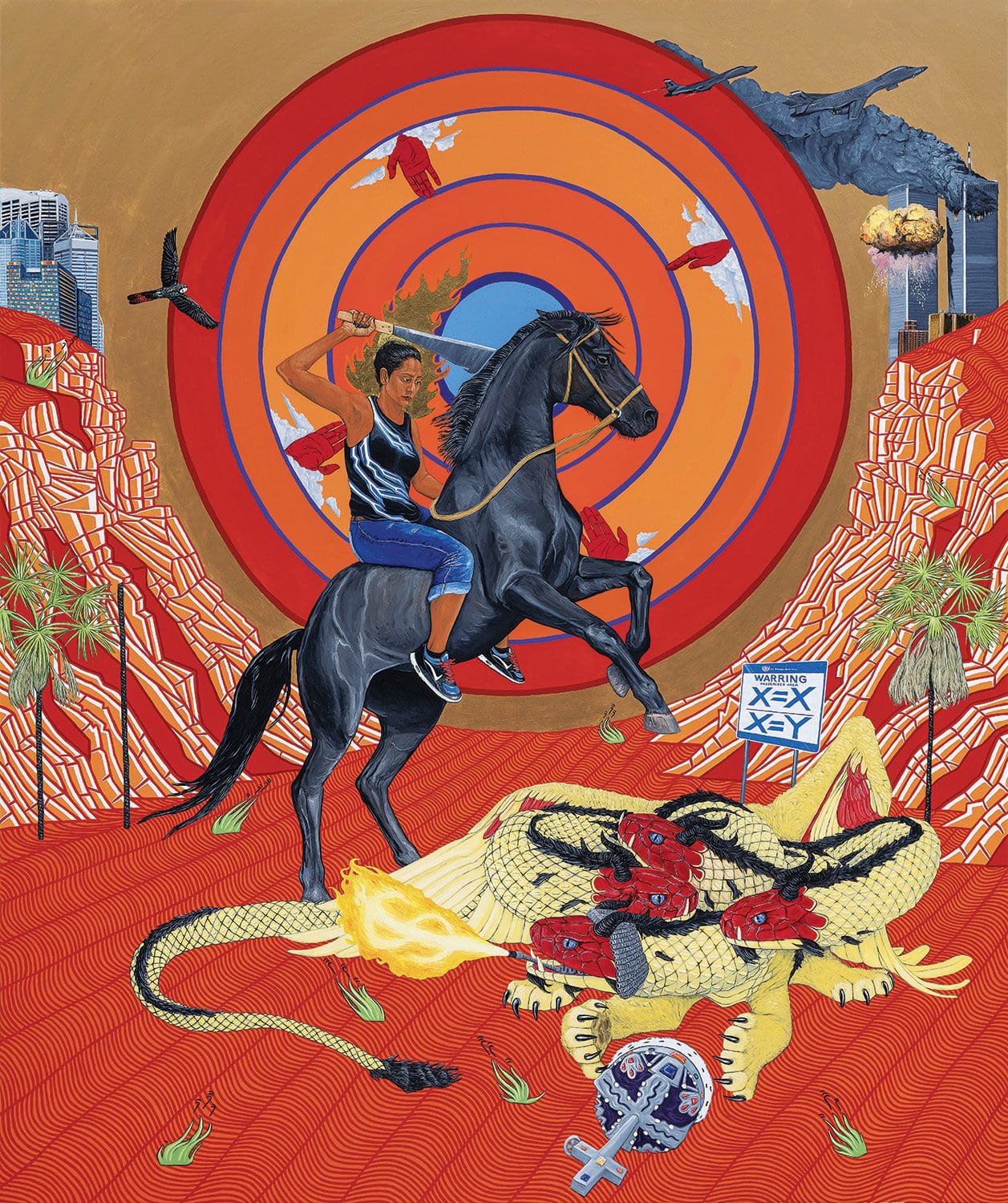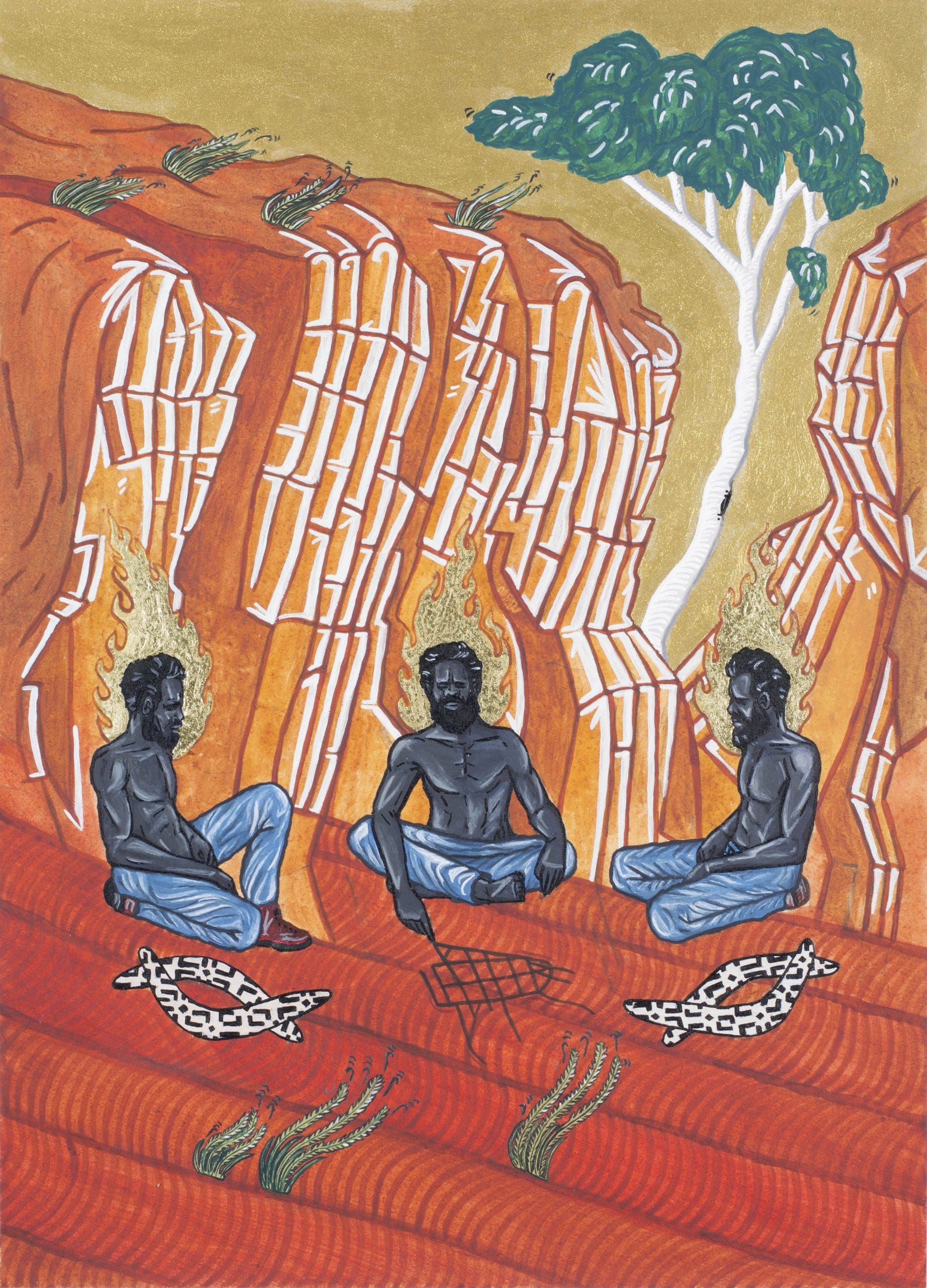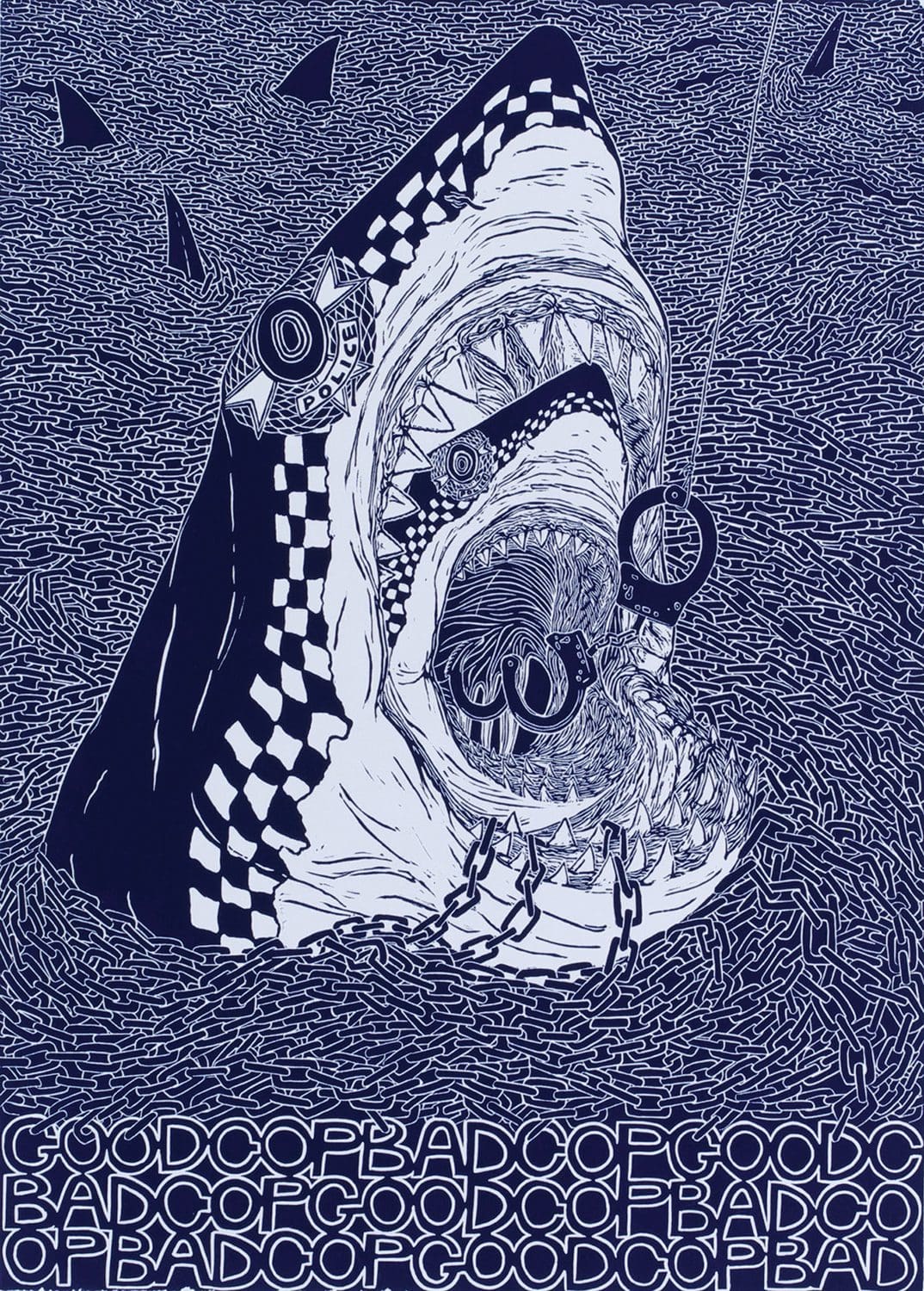
Piercing the veil
A new exhibition at Buxton Contemporary finds a rich complexity in the shadowy terrain between life and death.
Rich with symbolism and colour, the prints and paintings of Brisbane-based artist Ryan Presley give a sharp and deeply compassionate history of Indigenous experiences with governance and power in Australia. The artist scrutinises how law is enforced across this country, at times often violently and tragically administered; while also raising up Indigenous heroes of legal reform and community.
Western mythologies of colonialism and crusade form a kind of symbolic template that Presley plays with, adding his own brand of Australian iconography, from camo-print sharks to poolside recliners and Melbourne street maps.
Of Marri Ngarr (Moyle River) and Scandinavian migrant heritage, Presley is a finalist in the 2020 Telstra National Aboriginal & Torres Strait Islander Art Awards. Here, he tells us the potent stories behind five of his prints and paintings.

RYAN PRESLEY: The template for this work is the tradition of St George, who is still a prevalent symbol in Western art. His story is pro-war, pro-colonial: a foreign soldier arrives in the Middle East, where a dragon is terrorising the town. In some versions, George slays the dragon and takes possession of the town. In others, he injures the dragon and threatens to let it live unless the townsfolk convert to Christianity… then he takes possession of the town.
George was the patron saint of the [medieval] Crusades, which basically played out his fabled story in real life, colonising and sending wealth home. I wanted to use St George because his story indicates real culture, here in Australia. I have a female figure on a dark-toned horse, while the multi-headed dragon wears a judge’s wig and spits fracking burnoff. Historically, the town was painted looking on as George slayed the dragon, and here the landscape is marked by buildings that echo contemporary examples of occupancy and intervention: Australian banking and mining headquarters and the World Trade Centre attack that catalysed massive foreign military presence in Afghanistan. I want to question the colonial warrior idea: who benefits and loses from that?

RYAN PRESLEY: This was the first of a body of work I’ve been building for the past seven years. I used Christian iconography as a base, morphing elements of that canon to comment on our own political and social situations over the past decade.
These three men take the form of the Holy Trinity icon, three angels talking. I like the flattened perspective of the icons; it turns the landscape into a powerful, central character and that was important for this work, which considers the Northern Territory intervention in 2007. The intervention involved no real community consultation. When parliament suspended the Racial Discrimination Act it was a red flag that they were about to do something really inappropriate; the army was sent in, the Aboriginal Land Rights Act was undermined. The intervention played out slowly and still affects communities. I’m still working on this series, with larger compositions in oil.

RYAN PRESLEY: I worked on this painting for a few years, starting with the three figures, then adding and taking away little bits over time. It was a hard one. The walls on both sides were a turning point: they are a blend of the Don Dale Youth Detention Centre in the Northern Territory and Abu Ghraib Prison in Iraq. These two places are linked: both have used inhumane devices like mechanical restraint chairs, spit hoods and tear gas on inmates. A royal commission into child detention found that the Don Dale Detention Centre had shockingly used these restraints on kids as young as ten.
When it happens in Iraq, it’s regarded as a war crime, and yet we have a local version. The pool chairs by the graves—these reflect my perception of what’s happening. There are areas in our country where people are killed, or are kept in terrible poverty and not provided basic services—yet these same areas are relied on for tourism and recreation, and they represent Australia internationally. The chairs add realism: it’s that mix of life in Australia.

RYAN PRESLEY: There were several high-profile police-related deaths when I started art college in 2004. At Palm Island, Cameron Doomadgee died in a police cell. The wounds inflicted were comparable to someone who’d been in a 747 crash. His liver was split over his spine. The police alleged that Cameron was arrested for being a public nuisance, but eyewitnesses said he hadn’t done anything. He was singing, walking down the street. Sgt Chris Hurley was charged and acquitted, and it was later found that internal investigators from Townsville actually ate dinner at Hurley’s family home.
[When making the work] I was thinking about this and other similar cases, watching police swoop around Brisbane streets and parks like sharks. This shark swims in chains: restrictive for some, but empowering for the creatures, like police, who can navigate the system. There’s such ambiguity around police regulation that it often doesn’t matter. I was recently able to sell some prints of this work to support the court cases of families pursuing justice against police brutality.

RYAN PRESLEY: Aunty Rose was an interesting woman from far north Queensland. Her parents were very poor; both Stolen Generation. She lived in Cairns and hers was the first Aboriginal family to buy a house in the township. She worked in government and spoke out against the purposeful incompetence she witnessed, and was essentially fired for making an effort. Then she started up her own initiatives, like Douglas House, which is still operating.
It’s a shelter for homeless people of any background, and it caters for a lot of Aboriginal people. She started drug and alcohol rehabilitation programs. She helped compile and maintain direction on Native Title Claims. She was the first recipient of the Human Rights Medal in 1987. A compassionate and persistent person.
The Blood Money series makes a platform for people who have achieved great things, especially coming from adversity. It’s rewarding to put their image down in a work that audiences are receptive to; not buried in a book or archive.
2020 Telstra National Aboriginal & Torres Strait Islander Art Awards
Museum and Art Gallery of the Northern Territory
Until 31 January 2021
This article was originally published in the November/December 2020 print edition of Art Guide Australia.